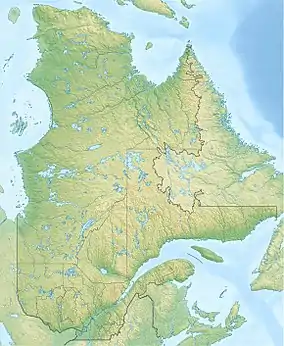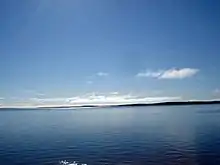Robert-Bourassa Reservoir
The Robert-Bourassa Reservoir (French: Réservoir Robert-Bourassa) is a man-made lake in northern Quebec, Canada. It was created in the mid-1970s as part of the James Bay Project and provides the needed water for the Robert-Bourassa and La Grande-2-A generating stations. It has a maximum surface area of 2,835 square kilometres (1,095 sq mi), and a surface elevation between 168 metres (551 ft) and 175 metres (574 ft).[1] The reservoir has an estimated volume of 61.7 cubic kilometres (14.8 cu mi), of which 19.4 cubic kilometres (4.7 cu mi) is available for hydro-electric power generation.[2]
| Robert-Bourassa Reservoir | |
|---|---|
 | |
 Robert-Bourassa Reservoir Location in Quebec | |
| Location | Baie-James, Jamésie Territory, Quebec |
| Coordinates | 53°45′N 77°00′W |
| Lake type | Artificial |
| Primary inflows | La Grande River |
| Primary outflows | La Grande River |
| Catchment area | 97,643 km2 (37,700 sq mi) |
| Basin countries | Canada |
| Surface area | 2,835 km2 (1,095 sq mi) |
| Average depth | 21.8 m (72 ft) |
| Max. depth | 137 m (449 ft) |
| Water volume | 61.7 km3 (14.8 cu mi) |
| Residence time | 0.5 years |
| Shore length1 | 4,550 km (2,830 mi) |
| Surface elevation | 175 m (574 ft) |
| 1 Shore length is not a well-defined measure. | |
The reservoir is formed behind the Robert-Bourassa Dam that was built across a valley of the La Grande River. This dam was constructed from 1974 to 1978, is 550 m (1,800 ft) wide at its base, and has 23 million m3 (30 million yd3) of fill.[3] There are another 31 smaller dikes keeping the water inside the reservoir.

See also
References
- Hydro-Québec – Robert-Bourassa Reservoir Archived 2007-02-23 at the Wayback Machine
- Hydro-Québec – Cinq principaux réservoirs d'Hydro-Québec
- Hydro-Québec – Robert-Bourassa Dam Archived 2007-02-23 at the Wayback Machine